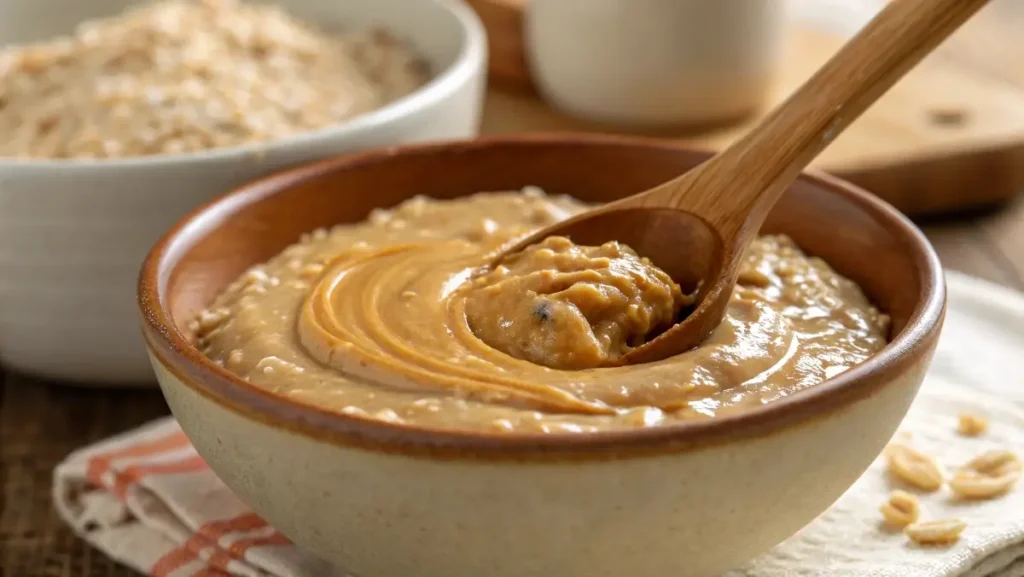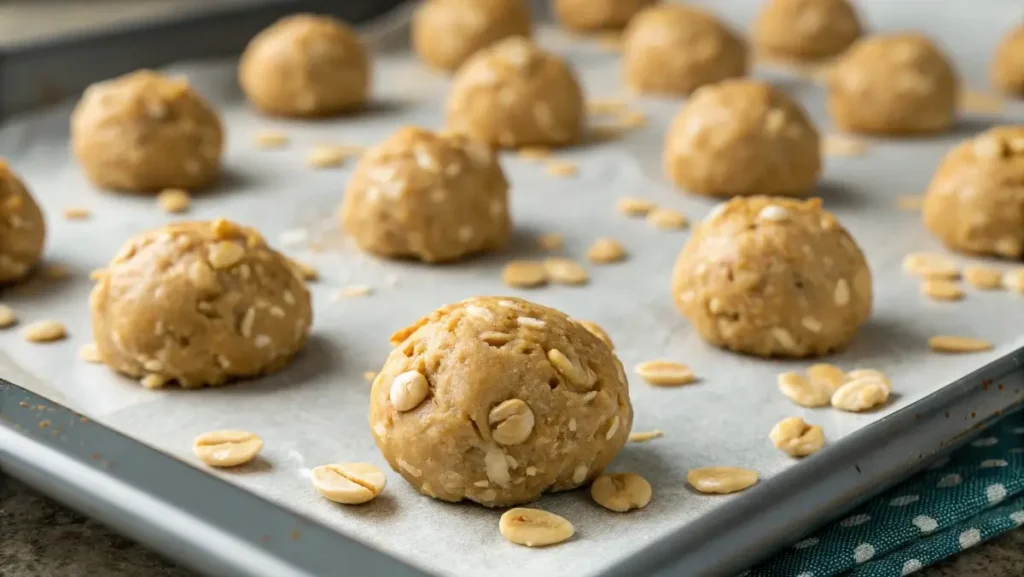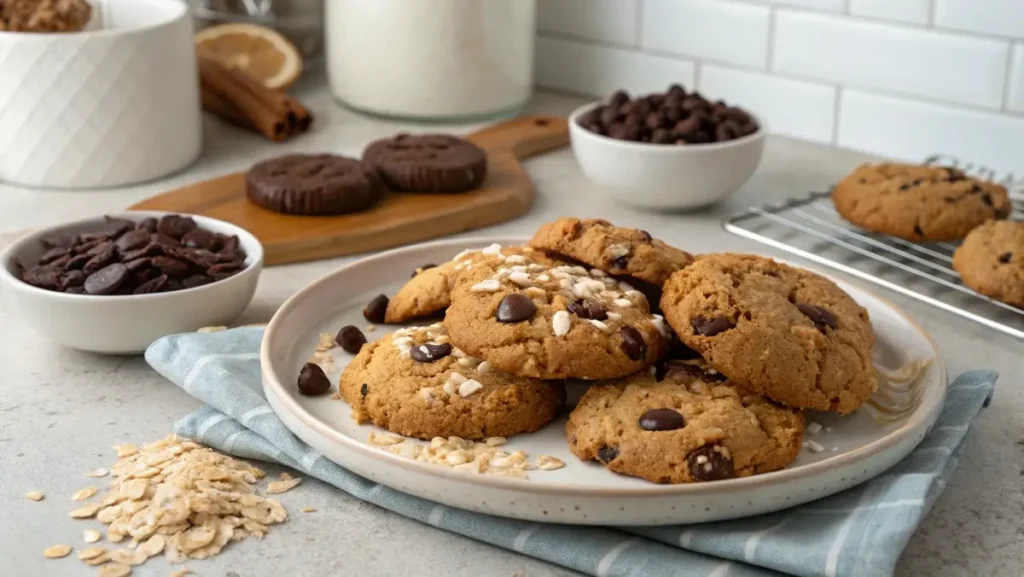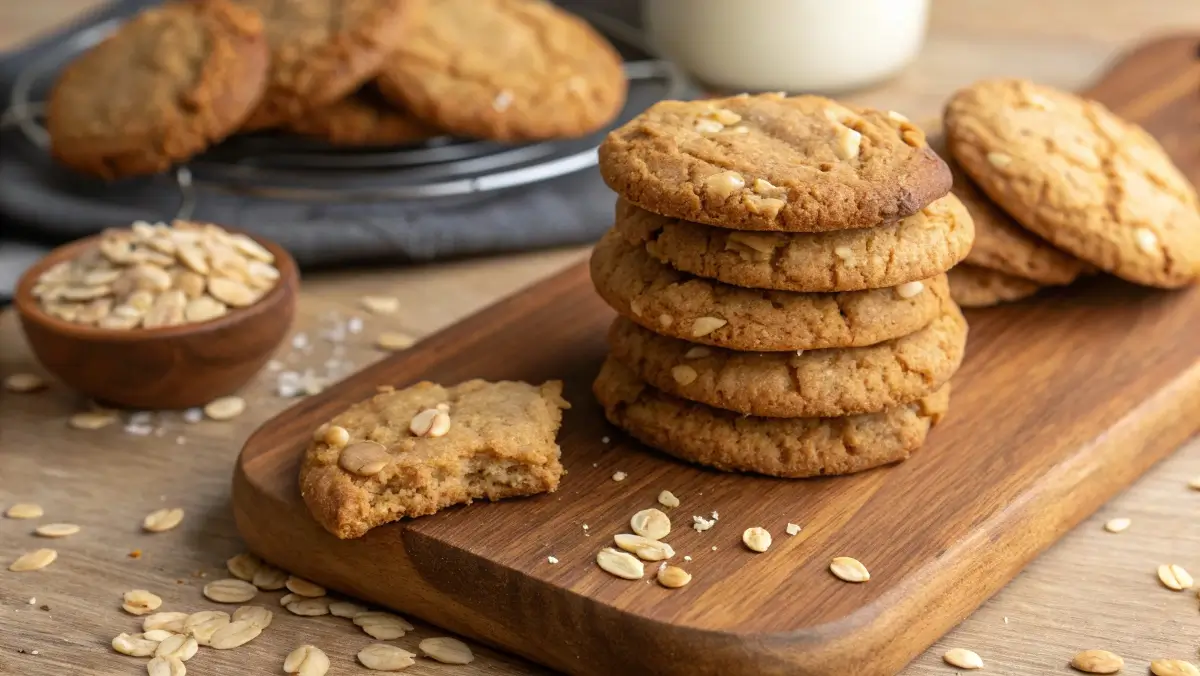Oatmeal Peanut Butter Cookies – The Ultimate Guide to Baking Healthy, Chewy Perfection
Craving something sweet that won’t leave you feeling guilty? Oatmeal peanut butter cookies are the chewy, protein-packed snack you’ve been searching for. In this comprehensive guide, we’ll explore why these cookies are more than just tasty — they’re a smart, wholesome choice for anyone who loves healthy indulgence. You’ll learn about their health perks, ideal ingredient proportions, frequent baking pitfalls, nutritious substitutions, and fun twists to keep your cookie jar exciting and fresh. From baking beginners to health-conscious foodies, this guide is designed to satisfy every curiosity and craving.
Looking for inspiration? Try Peanut Butter Overnight Oats for another delicious take on this classic combo.
Table of Contents
Introduction to Oatmeal Peanut Butter Cookies
What Are Oatmeal Peanut Butter Cookies?
Oatmeal peanut butter cookies combine the creamy richness of peanut butter with the wholesome texture of oats. These cookies stand out from traditional options by offering a chewy bite that’s naturally filling and loaded with nutrients. The base recipe typically includes rolled oats, natural peanut butter, eggs, sweetener, and a touch of baking soda or powder. They’re often gluten-free, depending on the oats used, and easy to adapt for dietary needs like dairy-free or refined sugar-free eating.
What makes them different from other cookies is their ability to balance indulgence and health. With no refined flour required, they use oats as the main dry ingredient — providing fiber, complex carbs, and sustained energy.
Why These Cookies Are a Staple in Healthy Baking
Cookies usually get a bad rap when it comes to nutrition, but oatmeal peanut butter cookies flip that script. Here’s why they’re a go-to for healthy snackers and bakers alike:
- High in Protein: Thanks to the peanut butter, one cookie can offer more protein than the average treat.
- Fiber-Packed: Oats are full of soluble fiber, which aids digestion and helps regulate blood sugar.
- Naturally Sweetened Options: Many recipes call for maple syrup, honey, or mashed banana instead of white sugar.
- Simple Ingredients: You probably have everything in your pantry already.
- Versatile: From breakfast bites to post-gym snacks, they serve multiple purposes.
They also support blood sugar control and promote fullness, making them ideal for those managing weight or energy levels. With the rise of clean eating and functional snacking, these cookies are becoming more than just a homemade favorite — they’re a smart wellness choice.
Nutritional Benefits of Oatmeal Peanut Butter Cookies
Are Oatmeal Peanut Butter Cookies Healthy?
Absolutely — when made with wholesome ingredients, oatmeal peanut butter cookies can be a genuinely healthy treat. Let’s break down why:
- Oats provide fiber, iron, and magnesium. They help regulate blood sugar levels and promote satiety.
- Peanut butter is a great source of plant-based protein and healthy fats, especially monounsaturated fats that support heart health.
- Natural sweeteners like maple syrup, honey, or mashed banana can be used in place of processed sugar to enhance flavor and reduce empty calories.
When these cookies are made with minimal, clean ingredients, they become a great option for a high-protein snack, post-workout energy bite, or even a breakfast cookie.

Nutrient Snapshot (per medium cookie – estimated):
| Nutrient | Amount |
|---|---|
| Calories | ~120–150 |
| Protein | 4–6g |
| Fiber | 2–3g |
| Sugar (natural) | 6–8g |
| Total Fat | 7–9g |
| Carbohydrates | 12–15g |
Don’t miss our Easy Protein Overnight Oats for another protein-rich oatmeal snack idea.
Key Ingredients That Make These Cookies Nutritious
The secret to turning a cookie into a healthier snack lies in the ingredient choices. Let’s look at what makes the difference:
1. Oats (Old-Fashioned or Rolled)
- Why it matters: Rich in beta-glucan fiber, oats help lower cholesterol and support digestive health.
- Pro tip: Avoid quick oats — they tend to get mushy and can spike blood sugar more rapidly.
2. Natural Peanut Butter
- Why it matters: Contains protein, vitamin E, magnesium, and healthy fats. Choose unsweetened and unsalted for best results.
- Pro tip: Stir the oil in thoroughly before using to ensure consistency.
3. Eggs (or Flax Eggs for Vegan)
- Why it matters: Eggs provide structure and a bit of extra protein. Flax or chia eggs are excellent vegan-friendly substitutes with added fiber.
4. Sweeteners (Honey, Maple Syrup, or Mashed Banana)
- Why it matters: These natural sweeteners offer trace minerals and are gentler on blood sugar.
- Pro tip: Mashed banana adds moisture and pairs well with peanut butter flavor-wise.
5. Add-Ins (Optional)
- Chia seeds or flaxseed: Boost omega-3 and fiber.
- Dark chocolate chips: Antioxidant-rich and lower in sugar than milk chocolate.
- Raisins or dried cranberries: Offer natural sweetness, but watch the portion size to keep sugar low.
By using whole, minimally processed ingredients, oatmeal peanut butter cookies become a nutritionally balanced snack — not just a dessert.
The Health Impact of Peanut Butter and Oats Combined
Is Eating Oatmeal with Peanut Butter Healthy?
Combining oats and peanut butter isn’t just delicious — it’s a smart move for your health. These two pantry staples create a nutritional power couple that fuels your body with the energy it needs, especially for busy mornings or mid-afternoon slumps.
Here’s why this duo works so well together:
1. Balanced Macronutrients
- Oats offer complex carbs and fiber for long-lasting energy.
- Peanut butter contributes healthy fats and protein, slowing digestion and helping you feel full longer.
Together, they support:
- Blood sugar balance
- Sustained energy release
- Reduced cravings between meals
2. Heart Health
- Oats are rich in soluble fiber, which can help reduce levels of LDL—or “bad”—cholesterol.
- Monounsaturated fats found in peanut butter help promote heart health by supporting balanced cholesterol levels and lowering inflammation.
Learn more about healthy fats with our Pistachio Butter Guide — another heart-smart spread to try.
3. Muscle Support
With roughly 7–10 grams of protein per serving when combined, oatmeal and peanut butter help rebuild muscle tissue after workouts and keep your metabolism active.
Looking for something indulgent yet nutritious? Check out this guide on Lemon Oatmeal No-Bake Cookies for a no-bake twist using oats.
Understanding the Glycemic Impact: Do Oatmeal Cookies Spike Blood Sugar?
It depends on the type of ingredients used. Traditional oatmeal cookies with refined flour and sugar can cause blood sugar spikes. But with the right swaps, oatmeal peanut butter cookies can be very blood-sugar-friendly. Here’s how:
Low-GI Ingredients That Help:
- Old-fashioned oats (lower glycemic index than quick oats)
- Natural peanut butter (low glycemic index)
- Natural sweeteners like stevia, erythritol, or small amounts of maple syrup
- Fiber add-ins like flaxseed or chia seeds slow down glucose absorption
Avoid These to Reduce Spikes:
- White sugar
- Refined flour
- High-glycemic add-ins (like large amounts of raisins or milk chocolate)
Don’t miss our guide to Keto Dark Chocolate Chips — a low-carb add-in option for your next cookie batch.
Perfecting the Recipe – Ingredients and Substitutions
Essential Ingredients for Chewy Oatmeal Peanut Butter Cookies
When you want your oatmeal peanut butter cookies to be irresistibly chewy and packed with flavor, it all starts with using the right ingredients in the right ratios. Here’s what you’ll need and why each one matters:
1. Old-Fashioned Rolled Oats
- Texture & fiber: These give your cookies a hearty bite and help them hold together.
- Why it matters: Instant oats turn mushy; steel-cut oats don’t cook evenly in cookies.
2. Natural Creamy Peanut Butter
- Healthy fats & flavor: Use unsweetened, unsalted peanut butter for best control over the taste and sugar content.
- Tip: Stir thoroughly before using to incorporate the natural oil separation.
3. Egg
- Binding agent: Holds everything together and adds structure.
- Vegan substitute: Use a flax egg (1 tbsp ground flaxseed + 3 tbsp water).
4. Sweetener
- Standard: Brown sugar or honey for moisture and chew.
- Healthier options: Maple syrup, coconut sugar, or mashed banana.
5. Baking Soda or Baking Powder
- Leavening: Adds a slight lift, especially if you want your cookies soft in the middle and crisp on the edges.
6. Vanilla Extract + Salt
- Flavor enhancers: Boost the natural sweetness and nuttiness.
Healthier Swaps: Low-Sugar, Gluten-Free, or Vegan Options
Want to tailor your recipe to fit a specific diet? These substitutions keep your cookies guilt-free and customizable:
For Low-Sugar Cookies:
- Swap out brown sugar for erythritol or monk fruit sweetener for a lower-sugar, keto-friendly option.
- Use unsweetened peanut butter to avoid added sugar.
For Gluten-Free Baking:
- Use certified gluten-free rolled oats.
- Double-check your baking powder/soda is gluten-free.
For Vegan Oatmeal Peanut Butter Cookies:
- Swap egg for a flax egg.
- Use maple syrup or agave instead of honey.
- Add vegan dark chocolate chips for extra indulgence.
For High-Protein Cookies:
- Boost the nutritional value by mixing in a scoop of vanilla or peanut butter-flavored protein powder.
- If the dough feels dry, add 1 to 2 tablespoons of almond milk to improve moisture and texture.
Don’t miss our Gluten-Free Soft Pretzels for another gluten-friendly baking treat!
Ingredient Ratios (Standard Batch – 12 Cookies)
| Ingredient | Quantity |
|---|---|
| Rolled Oats | 1 cup |
| Peanut Butter | ¾ cup |
| Brown Sugar or Maple | ½ cup |
| Egg | 1 large |
| Baking Soda | ½ tsp |
| Vanilla Extract | 1 tsp |
| Salt | ¼ tsp (omit if PB is salted) |
These ingredients create the perfect chewy texture while keeping things simple, healthy, and delicious.
Baking Instructions and Tips for the Best Cookies

Step-by-Step Recipe for Perfect Oatmeal Peanut Butter Cookies
This straightforward method creates irresistibly soft and chewy oatmeal peanut butter cookies every time. Whether you’re a seasoned baker or trying your first batch, these steps guarantee consistency.
Ingredients Recap:
- 1 cup rolled oats
- ¾ cup natural peanut butter
- ½ cup brown sugar or maple syrup
- 1 large egg
- ½ tsp baking soda
- 1 tsp vanilla extract
- ¼ tsp salt (optional)
Instructions:
Step 1: Preheat the oven
- Preheat to 350°F (175°C) and line a baking sheet with parchment paper.
Step 2: Mix wet ingredients
- In a medium bowl, combine peanut butter, sweetener, egg, and vanilla extract. Mix until smooth and well-blended.
Step 3: Add dry ingredients
- Stir in the oats, baking soda, and salt until a soft dough forms. If it’s too thick, add 1–2 teaspoons of milk or water.
Step 4: Scoop and shape
- Use a spoon or cookie scoop to portion the dough onto the baking sheet. Gently press each cookie with a fork in a crisscross design for that classic peanut butter cookie look.
Step 5: Bake
- Bake for 9 to 11 minutes, or until the edges are lightly golden. Do not overbake — they firm up as they cool.
Step 6: Cool
- Allow the cookies to cool on the baking sheet for 5 minutes before moving them to a wire rack to finish cooling.
Learn more about how to nail textures in gluten-free sweets with our Date Palm Recipe, a natural sweetener idea you can use in cookies.
The Most Common Mistakes When Making Oatmeal Cookies and How to Avoid Them
Even simple recipes come with their quirks. Here’s what you want to avoid:
1. Using Quick or Instant Oats
- Why it’s a problem: They break down too fast, making the cookies dense or mushy.
- Fix: Always use old-fashioned rolled oats for proper texture.
2. Overbaking
- Why it’s a problem: Cookies may seem too soft when hot, but overbaking dries them out.
- Fix: Remove them when the edges are just turning golden — they’ll set up as they cool.
3. Using Sugary or Processed Peanut Butter
- Why it’s a problem: Adds unnecessary sugar, salt, and hydrogenated oils.
- Fix: Use natural peanut butter (just peanuts).
4. Skipping Salt
- Why it’s a problem: Without salt, flavors fall flat.
- Fix: Add a pinch of salt even if your peanut butter contains some.
5. Overmixing
- Why it’s a problem: Can make cookies tough.
- Fix: Stir just until combined after adding oats.
6. Too Much Sweetener
- Why it’s a problem: Can make cookies spread too much or burn quickly.
- Fix: Stick to the measured quantity. If using banana as sweetener, reduce other liquids.
Discover great ideas like our Sourdough French Toast Bake for more balanced sweet breakfasts.
With the right process and ingredients, you’ll get that perfect chewy center and crisp edge combo every time.
Storage, Freezing & Meal Prep Tips
How to Store Oatmeal Peanut Butter Cookies for Freshness
Once you’ve baked the perfect batch of oatmeal peanut butter cookies, keeping them fresh is essential to maintain their soft and chewy texture.
Room Temperature Storage:
- How long? Up to 5 days
- Best method: Store in an airtight container lined with parchment or wax paper between layers.
- Tip: Keep a slice of bread inside the container — it helps prevent cookies from drying out.
Refrigerator Storage:
- How long? Up to 10 days
- Best method: Place in a sealed container. For the best flavor and texture, let the cookies reach room temperature before serving.
Learn more about storing gluten-free items properly in our Gluten-Free Summer Salads roundup, which also uses fresh and preserved ingredients.
Freezer Tips for Long-Term Storage and Batch Baking
Oatmeal peanut butter cookies freeze incredibly well — both the dough and the baked cookies.
To Freeze the Dough:
- Step 1: Scoop dough into balls and place on a parchment-lined tray.
- Step 2: Freeze until solid (about 2 hours), then transfer to a zip-top freezer bag.
- Step 3: Label with date and bake time (add 1–2 minutes if baking from frozen).
Storage life: Up to 3 months
To Freeze Baked Cookies:
- Step 1: Cool cookies completely.
- Step 2: Wrap individually in plastic wrap or layer with parchment in a container.
- Step 3: Thaw at room temperature or warm in the oven at 300°F for 5–7 minutes.
Pro Tip: Flash freezing cookie dough makes weekday baking effortless. Just grab, bake, and enjoy fresh cookies whenever the craving hits.
Batch Meal Prep Idea:
Make a double batch of dough on Sunday. Bake half and freeze half — now you have ready-to-go snacks for the whole week or more.
Don’t miss our Cuisinart Ice Cream Maker Recipes to pair with these cookies for the ultimate dessert combo.
Freezing and storing your oatmeal peanut butter cookies the right way means they’ll stay soft, flavorful, and just as good as day one.
Creative Twists and Variations on the Classic Recipe
One of the best things about oatmeal peanut butter cookies is their versatility. Once you’ve mastered the base recipe, you can tweak it endlessly to match your taste, dietary goals, or cravings. Here are the most popular (and tasty) ways to get creative with your cookie game.

Add-In Ideas: Chocolate Chips, Raisins, Coconut, and More
A few simple mix-ins can transform your cookies from basic to bakery-worthy. Try these combinations to create unique flavor profiles and textures.
1. Chocolate Chips
- Dark chocolate chips add antioxidants and richness.
- For a low-carb twist, use keto chocolate chips.
- Try mixing in white chocolate chips for a peanut butter cup-inspired cookie.
2. Dried Fruit
- Add raisins, dried cranberries, or chopped dates for a sweet, chewy contrast.
- Limit to ¼ cup to keep sugar levels moderate.
3. Coconut Flakes
- Use unsweetened shredded coconut to boost texture and fiber.
- Toast lightly for extra crunch and flavor.
4. Nuts & Seeds
- Add chopped pecans, almonds, or walnuts for crunch.
- Stir in chia seeds, flaxseed, or hemp hearts to raise nutritional content.
5. Spices
- Add ½ tsp cinnamon, a pinch of nutmeg, or even a dash of clove to warm up the flavor.
- A sprinkle of sea salt on top brings out the peanut flavor even more.
Popular Flavor Combos Table:
| Add-In Combo | Flavor Profile |
|---|---|
| Dark chocolate + coconut | Mounds bar vibe |
| Raisins + cinnamon | Oatmeal raisin remix |
| Chopped pecans + maple syrup | Southern-style cookie |
| Banana + dark chocolate | Chunky monkey version |
| Almonds + white chocolate chips | Creamy and crunchy |
Looking for bold dessert upgrades? Explore our Delightful Asian Desserts for flavor-pairing ideas that may surprise you.
How to Turn Them into No-Bake or Protein-Packed Cookies
If you want your cookies faster — or with an added boost — try one of these versions:
No-Bake Oatmeal Peanut Butter Cookies
- Mix together 1 cup of oats, ½ cup of peanut butter, and ¼ cup of honey or maple syrup for a simple, wholesome base.
- Mix and press into small rounds or bars.
- Chill for 30 minutes. No oven required.
Optional Add-ins: Cocoa powder, chia seeds, shredded coconut
High-Protein Version
- Replace ¼ cup oats with 1 scoop protein powder (vanilla or peanut butter flavor).
- Add 2 tbsp almond milk to balance moisture.
- Use flaxseed for fiber and texture.
Learn more about energy-boosting snacks in our Pre-Workout Drink Homemade recipe — a great pairing for these cookies.
Experimenting with mix-ins and styles keeps your baking fresh and fun, while still keeping it wholesome.
Comparing Cookie Health Values
Not all cookies are created equal — especially when it comes to health. If you’re trying to make smarter snack choices, it’s worth knowing how oatmeal peanut butter cookies stack up against other popular cookie types.
Are Oatmeal Cookies Actually Healthy Compared to Other Types?
Compared to classic cookies like chocolate chip, sugar, or snickerdoodles, oatmeal peanut butter cookies often come out on top — if made with clean, whole ingredients.
Nutritional Comparison Table (1 medium cookie, average values):
| Cookie Type | Calories | Sugar | Fiber | Protein | Healthy Fats |
|---|---|---|---|---|---|
| Oatmeal Peanut Butter | 130 | 6g | 2.5g | 5g | Yes |
| Classic Chocolate Chip | 160 | 12g | 0.5g | 1g | No |
| Sugar Cookie | 170 | 14g | 0.2g | 1g | No |
| Snickerdoodle | 150 | 11g | 0.3g | 1g | No |
| Oatmeal Raisin | 140 | 9g | 1.5g | 2g | Minimal |
Verdict: Oatmeal peanut butter cookies offer:
- More fiber and protein
- Lower sugar (if natural sweeteners used)
- Heart-healthy fats
This combination means they not only satisfy your sweet tooth but also stabilize blood sugar and promote satiety, unlike traditional cookies that cause quick energy crashes.
Learn more about low-glycemic sweets like our Keto Edible Cookie Dough for a guilt-free dessert option.
What Is the Healthiest Cookie Option Available Today?
While “healthy” can be subjective, here’s how different options measure up by typical health standards:
Top Healthiest Cookie Types:
- Oatmeal Peanut Butter Cookies
- High fiber and protein
- Customizable sugar content
- Heart-healthy fats
- Protein Cookies
- Great for muscle recovery
- Some may use sugar alcohols — check labels
- Almond Flour Cookies
- Gluten-free and low-carb
- Rich in vitamin E and healthy fats
- No-Bake Energy Bites
- Made with oats, nut butter, and seeds
- No heat means nutrients stay intact
Curious about plant-based healthy desserts? Don’t miss our Vegan Yum Yum Sauce Recipe for a savory twist to healthy snacking.
Ultimately, the healthiest cookie is one made with real ingredients, minimal sugar, and designed to support your dietary needs — and oatmeal peanut butter cookies check all those boxes.
Conclusion: Why You Should Try Oatmeal Peanut Butter Cookies Today
If you’re searching for a cookie that satisfies your sweet tooth and supports your wellness goals, oatmeal peanut butter cookies are the answer. They’re easy to make, endlessly customizable, and packed with real ingredients that deliver flavor, texture, and nutrition in every bite.
By combining the hearty fiber of oats with the protein-rich goodness of peanut butter, these cookies become more than just a treat — they become a smart snack choice. Whether you need a quick post-workout bite, a lunchbox-friendly snack, or a cozy dessert, this cookie has your back.
Best of all, you can tweak the recipe to match your lifestyle — vegan, gluten-free, low sugar, or protein-enhanced. And with proper storage, meal prep, and freezing tips, you’ll always have a batch on hand when cravings strike.
Discover great ideas like our Homemade Energy Drink Recipe to pair with these cookies for a complete snack combo.
FAQs
Are Peanut Butter Oatmeal Cookies Healthy?
Yes — when made with natural peanut butter, old-fashioned oats, and minimal added sugar, these cookies offer a great mix of protein, fiber, and healthy fats. They’re far healthier than typical store-bought cookies loaded with refined flour, sugar, and hydrogenated oils.
What Are the Most Common Mistakes When Making Oatmeal Cookies?
Using instant oats (results in mushy cookies)
Overbaking, which dries them out
Not mixing peanut butter well, leading to uneven texture
Skipping salt, which flattens the flavor
Overloading add-ins, causing spreading or underbaking
Avoid these, and you’ll be set for chewy perfection every time.
Is Eating Oatmeal with Peanut Butter Healthy?
Definitely. Oatmeal provides slow-digesting carbs and fiber, while peanut butter offers healthy fats and protein. Together, they create a balanced meal or snack that supports energy, satiety, and heart health.
Are Oatmeal Cookies Actually Healthy?
It depends on how they’re made. Traditional oatmeal cookies may contain processed flour, sugars, and unhealthy oils. But versions using whole oats, natural nut butter, and natural sweeteners can be rich in nutrients and suitable for everyday snacking.
What Is the Healthiest Cookie?
The healthiest cookie combines whole food ingredients like:
Oats or almond flour
Nut butter or avocado
Natural sweeteners
Minimal processing
Oatmeal peanut butter cookies hit most of these marks and can be tailored to low-carb, gluten-free, or vegan diets.
Do Oatmeal Cookies Spike Blood Sugar?
Traditional ones often do due to refined sugar and flour. However, oatmeal peanut butter cookies made with fiber-rich oats, protein, and healthy fats can actually help moderate blood sugar levels — especially when sugar content is reduced.

